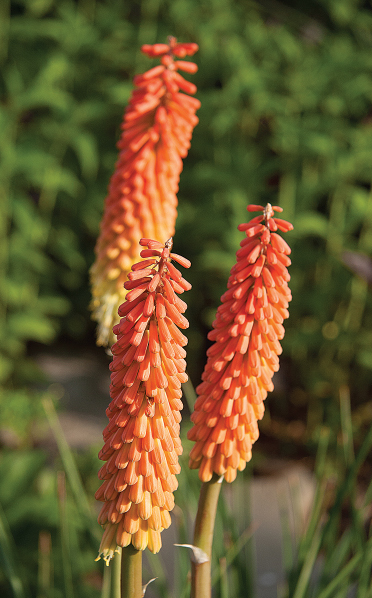Q; I tried growing kniphofia for the first time this year, and although they did bloom and were very pretty, they were warped and curved, unlike what I have seen in catalogs. I fed them a few times with a high-nitrogen fertilizer for maximum growth, but now I am wondering if that was the right thing to do. Help!
Debbie Turner, Cary
A: Kniphofia, more commonly known as red hot poker, doesn't really need a big boost of nitrogen because, while this nutrient will help the plant grow longer, longer, it won't make the supporting bloom stems any stronger, stronger. This probably created the flop effect on your plants, but I also have to mention sunlight. Red hot pokers should be placed in an area that basks in sun for most of the day — anything less can also cause the flower cones to droop and dip.
Q: I was reading the article you wrote in May's Cary Magazine on the Gloriosa plant. Where can I buy one?
Mary Bentley, Cary
A: For the last few years, I have been picking mine up at local big box home improvement stores. Every spring, they usually have Gloriosa lilies in their bulb bins, but these beauties tend to sell out fast. A good Plan B is to check online at Amazon or eBay. Search under "Gloriosa superba," and for faster results, be sure to order bulbs, not seeds.
Q: I am new to the Research Triangle area, and coming from Salt Lake City, certainly new to gardening in this region. I really do like native plants, as I find them to generally be steady performers in a tended garden. Do you have any advice as to how I can get started with North Carolina native plants?
Shelly Davis, Apex
A: Go west — not back to Utah but rather 30 minutes down the road to Chapel Hill and the North Carolina Botanical Garden. If you want to see what native pretties are possible for your garden, this first-rate showcase of plants indigenous to our state is a good place to start. What I really like about this public garden (admission is free) is that it doesn't just display local natives but rather wild plants from the three distinct regions of North Carolina: Coastal, Piedmont and Mountains. For more info, directions and opening times, check out their website at ncbg.unc.edu.
And while you are in Chapel Hill, make a day of it by stopping by Niche Gardens, one of the better native plant nurseries in the Southeast, in my humble opinion. For additional information, as well as to see the garden goodies they sell, go to their website at nichegardens.com.
To Do in the Garden
September
• Indoor plants that have vacationed out on the porch or patio this summer should be returned inside before nighttime temperatures dip into the 50s. Check them carefully for bugs and clusters of insect eggs.
• Falling leaves will soon provide plenty of fuel for the organic cooking of a compost pile, so find and clear a good location to build one of these soil-conditioning garden helpers.
• Curb your fetish to fertilize outdoor garden plants with high-nitrogen products. Now is not the time to encourage tender, new growth on perennials and woody ornamentals because the plants need to toughen up while they are preparing for the coming winter.
• Perennial herbs such as mint, parsley, chives and lemon balm can now be divided. And think about fixing up a few pots of these helpful herbs for an indoor kitchen garden this winter. For the best results, place the pots in a sunny, southern-facing window.
October
• Pansies! Now is prime planting time for these persistent winter pretties. Adding a time-release fertilizer around the plants will help encourage their flower production through the coldest part of the year, as will deadheading spent blooms over the winter.
• To help prevent black spot on roses next year, after leaf fall, rake up and discard the summer mulch and debris from under the plants, and replace with a fresh winter mulch. Do not compost the rakings.
• Landscape to conserve energy? You bet, especially if you plant evergreen trees and shrubs on the northern and northwestern sides of your house to help block heat-robbing effects of the coldest winter winds, which usually blow in from the north.
• Still have seed packs left over from your buying binge this growing season? To properly store them, put the packets in an airtight container and place in a cool, dry, dark location to await a second chance to show off next spring.
Timely Tip
 Early autumn is the prime time to divide and transplant peonies. Wait until the leaves have been bit by the first frosts and then cut the foliage back to ground level. Carefully dig the peony clumps up, trying to save as much of the root systems as possible. For better producing divisions, make sure that each one that is cut has at least four to five "eyes" and some portion of the root system.
Early autumn is the prime time to divide and transplant peonies. Wait until the leaves have been bit by the first frosts and then cut the foliage back to ground level. Carefully dig the peony clumps up, trying to save as much of the root systems as possible. For better producing divisions, make sure that each one that is cut has at least four to five "eyes" and some portion of the root system.
Keep in mind that established peonies resent being yanked out of the ground. They usually show their displeasure by blooming sparsely the year after transplanting and not getting into the full swing of showing off flowers until a few years after being relocated.
L.A. Jackson is the former editor of Carolina Gardener Magazine.
Want to ask L.A. a question about your garden?
Contact him by email at lajackson1@gmail.com.
- Gemimah Hernandez Fuentes, Program Coordinator, SAFEchild; Owner, A Better Choice: Rise Up Counseling
- Dr. Tracy Weeks, Chief Academic & Digital Learning Officer, N.C. Department of Public Instruction
- Angela Newman, Nursing Director, Women’s Pavilion and Birthplace, WakeMed Cary
- Lisa Grimes, President & CEO, PurThread
- Meet the 2015 Women of Western Wake
- Awesome Autumn: Your Guide to Fall Fashions
- ‘Fore’ the Community
- Cycle of Hope
- Follow Your Heart
- Charity Spotlight: HopeSpring Village
- Make Room for Mushrooms
- Your Garden Questions, Answered
- Jenn Mann, Vice President of Human Resources, SAS







